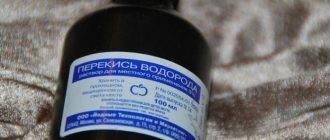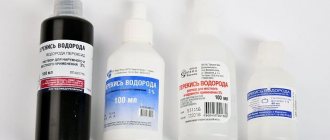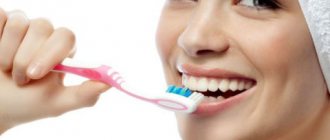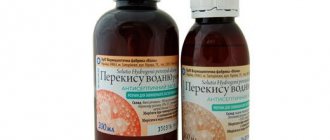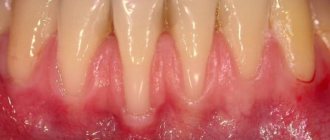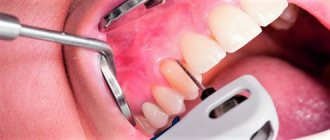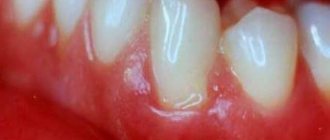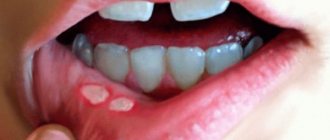Due to the coronavirus pandemic around the world, more and more people are stocking up on disinfectants.
However, in the face of their shortage, people are looking for alternatives to traditional cleaning products.
One such remedy is hydrogen peroxide, which has been a first aid treatment for wounds and cuts for many generations.
- Disinfection with hydrogen peroxide
- Uses of hydrogen peroxide
- Disinfectant soak
- All-purpose cleaner
- Hand sanitizer at home
- Storing hydrogen peroxide
- Precautionary measures
The material has an information and reference function! Before using any products or services, you must consult a specialist!
Disinfection with hydrogen peroxide
According to the Centers for Disease Control and Prevention, hydrogen peroxide kills fungi, bacteria, viruses and mold spores.
.
It is a stable and effective antiseptic against viruses when used on hard, non-porous surfaces.
Hydrogen peroxide (H2O2) is a powerful disinfectant that kills bacteria such as staph and viruses including H1N1, SARS and coronaviruses.
It is typically sold in the form of a 3% or 6% solution and can be used directly straight from the bottle.
This is because hydrogen peroxide in fully concentrated form is too strong for home use and is actually used as rocket fuel and a bleaching and corrosive agent in manufacturing.
Hydrogen peroxide (H2O2) is a highly reactive substance and acts on microbes by oxidation. This process occurs when reactive oxygen atoms interact with the electrons of other cells, resulting in the destruction of the cell walls that form the bacteria.
How to use it correctly
Very often, patients ask: why is the procedure for treating wounds with peroxide necessary? In fact, it quickly and effectively helps remove bacteria, as well as clear the mouth and throat of pus accumulation. Very often the drug is used to treat periodontal disease and stomatitis. In addition, many doctors claim that treatment with this remedy helps to avoid sinusitis. In short, there are plenty of benefits from hydrogen peroxide. The main thing when using it is to take into account some rules:
- This drug must be diluted in water. In concentrated form, it is a dangerous poison. For example, three grams of a concentrated pharmaceutical substance is enough to cause death.
- For treatment, you can use not only a liquid solution, but also a tablet of a drug such as “Hydroperit”.
- It is advisable not to do the procedure more than five times a day, and the time interval should be at least three hours. In case of an acute inflammatory process with a large accumulation of pus, you can use an antiseptic a little more often.
- You should not leave hydrogen peroxide in your mouth after the procedure. Be sure to rinse your mouth with water again.
It is enough to simply lubricate the tonsils with a diluted solution using a cotton swab or ear swabs.
Using hydrogen peroxide for disinfection
When it comes to all-purpose, non-toxic cleaners, few things compare to a 3% hydrogen peroxide solution. It can be used to disinfect various surfaces.
Kitchen sink
Wet the surface of the sink. Then clean the sink with baking soda using a sponge. Once you have wiped the entire surface, apply a 3% hydrogen peroxide solution and leave for 5 minutes before rinsing the surface.
Countertop and cutting boards
According to experts, wiping countertops or cutting boards with a 3% hydrogen peroxide solution helps kill E. coli and salmonella on hard surfaces if left for 10 minutes at room temperature.
Carefully! If the countertop is made of marble or granite, then hydrogen peroxide, although it will not cause harm, is not suitable for constant use, as it can slightly damage the surface.
Bin
After washing the trash can with soap and water, spray a solution of hydrogen peroxide and water in a 1:1 ratio into the container. Leave the bucket to dry in the sun for several hours. Hydrogen peroxide not only helps clean the surface, but also kills germs in the trash can.
Refrigerator and dishwasher
Because hydrogen peroxide is non-toxic, it can be used to clean areas where food and dishes are stored. Spray the outside and inside of your refrigerator and dishwasher, let it sit for a few minutes, and then wipe with a clean cloth.
Sponges for washing dishes
Soak dish sponges for 10 minutes in a 1:1 mixture of hydrogen peroxide and water in an empty bowl. Then rinse the sponges thoroughly.
Toilet
Hydrogen peroxide is effective at killing microorganisms, including bacteria, fungi, viruses and mold, making it an excellent toilet cleaner.
To clean the toilet, add 1/2 cup of 3% hydrogen peroxide solution to the toilet bowl to kill germs and make the toilet surface shiny.
Leave the solution for 20 minutes for greater effectiveness.
Mirrors and glass surfaces
Spray a 1:1 solution of hydrogen peroxide and water onto the glass surface, then wipe it with paper towels, a lint-free cloth or newspaper to avoid streaks.
Shower stall
Mold easily forms in the damp environment of a shower stall.
To kill it without inhaling toxic bleach fumes, spray an undiluted 3% hydrogen peroxide solution and leave for 30 minutes. Rinse the surface.
Door handles
Wipe or spray a 3% hydrogen peroxide solution on the door handles and leave for 5 minutes. Then wipe the surface.
Floors
To clean and disinfect floors, you need to do the following:
Mix equal parts water and hydrogen peroxide in a bucket.
Wipe the floors as usual and let them dry.
It is worth remembering the bleaching properties of hydrogen peroxide, so it is better to test its effect on colored and wooden floors before using it.
Disinfectant soak
In addition to wiping down hard surfaces, you can make a soak product.
Simply fill a container with hydrogen peroxide and use it to soak children's toys, toothbrushes, and dental retainers for 10-20 minutes.
Let them dry and use as usual.
All-purpose cleaner
While hydrogen peroxide works great on its own, you can mix it with other home remedies to enhance its cleaning and disinfecting properties.
Try the following tool:
- Mix 1 cup of hydrogen peroxide solution and 2 cups of distilled water, add 2 teaspoons of lemon juice.
Mix everything in a spray bottle and shake.
Use this mixture to clean a wide variety of surfaces. Lemon not only gives a pleasant smell, but also helps to get rid of dirt better.
Treatment of wounds with stomatitis
The solution for this disease should be less concentrated so as not to cause acute pain. Considering the rather aggressive composition of the product, some sources recommend the following proportions for gargling with hydrogen peroxide: ten milliliters per one hundred and fifty grams of water. It can also be used no more than three times a day.
When treating children, it is best to treat wounds with a gauze-cotton swab dipped in a weak solution. A similar procedure is recommended for adult patients to avoid the risk of ingesting the drug. It is highly not recommended to combine treatment with peroxide with the use of any anti-inflammatory drugs. For example, if a patient takes antibiotics, then it is advisable to first undergo a course of treatment and only then, if there are residual diseases, use hydrogen peroxide. The best option would be parallel treatment with traditional medicine.
Hand sanitizer at home
Recipe 1
This antiseptic recipe was proposed by WHO. To make hand sanitizer at home you will need:
- Ethyl alcohol 96% – 833 ml
- Hydrogen peroxide 3%—41.7 ml
- Glycerin - 14.5 ml
- Boiled or distilled water
Mix all the ingredients and add them to a spray bottle.
Dilute the mixture with water to the desired consistency. Shake lightly and leave for 72 hours.
Apply the antiseptic to the entire surface of your hands, treating for at least 30 seconds.
Recipe 2
You can also use another hand sanitizer recipe
from hydrogen peroxide:
- ⅔ cup of isopropyl alcohol at least 70%
- 2 tablespoons hydrogen peroxide
- ⅓ cup liquid aloe vera
This antiseptic is convenient to take with you and use to disinfect your hands if you cannot wash your hands.
Recipe 3
Required components:
alcohol tincture (chamomile or calendula) – 50 ml;
boiled water – 50 ml;
glycerin – 30 ml;
lemon essential oil – 5 drops.
All components must be thoroughly mixed and placed in a bottle. An antiseptic will help get rid of harmful microorganisms, glycerin will make the skin of your hands softer, and the essential oil will give them a pleasant lemon aroma.
Recipe 4
Mix until smooth and place in a closed container: tea tree essential oil (7 drops), alcohol tincture (50 ml), aloe vera gel (1 tbsp.). Tea tree oil and alcohol cleanse hands well, and aloe vera gel moisturizes them.
All recipes are very easy to prepare and, according to experts, very effective. They will help protect against the virus and prevent infection from entering the human body.
Storing hydrogen peroxide
In order for hydrogen peroxide to serve as an effective disinfectant, it is important to store it correctly.
Hydrogen peroxide breaks down when exposed to light, which is why it is sold in dark plastic bottles.
Store the hydrogen peroxide bottle in a cool, dry place to ensure it remains stable for a long time.
Precautionary measures
Hydrogen peroxide has many beneficial cleaning and disinfecting properties on its own. However, you need to be careful when mixing it with other substances.
For example, you should not mix hydrogen peroxide with bleach, or hydrogen peroxide with white vinegar, in the same container because such mixtures can cause undesirable effects.
However, you can wipe down the surface with hydrogen peroxide first and then vinegar (not mixing!) as a powerful way to combat bacteria and viruses on hard surfaces.
User reviews
In their reviews of rinsing with hydrogen peroxide, users often praise this product and recommend it to others. For example, they treat teeth with periodontal disease and also freshen breath. Recently, this method has become quite widespread. The popular antiseptic perfectly destroys germs and makes your breath fresh. However, users do not recommend using it too often. The application must be softened with some folk remedies. For example, after an antiseptic, they usually drink tea with honey or take a multivitamin complex with vitamin A to heal the damaged mucosa. If the procedure of rinsing with peroxide is carried out more than once a week, tooth enamel may be damaged.
Some people rinse with hydrogen peroxide according to the following scheme: ten drops of concentrated liquid are stirred in one hundred grams of water. For convenience, a regular pipette is usually used. Gargle with the resulting solution three to four times a day. The very next day you can notice significant relief. The redness of the tonsils decreases by the evening of the second day, and on the third day the pain almost completely disappears.
Gargling with hydrogen peroxide is often recommended by doctors. However, experts do not recommend using the product to treat young children. Some people are quite effective at stopping nosebleeds with this drug. Usually, a teaspoon of peroxide is diluted in one hundred milliliters of purified water, after which a cotton swab is moistened in it and placed in the nose during bleeding.
In short, this drug has proven itself to be excellent. The main thing when rinsing your mouth with hydrogen peroxide is not to exceed the permissible concentration and not to increase the number of procedures. Otherwise, an overdose of the drug may occur and irritation of the stomach and oral mucosa may occur.
